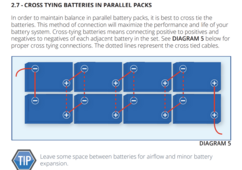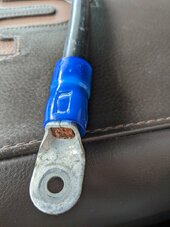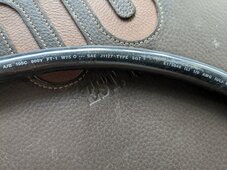I've been thinking about my 2p8s (or 8s2p) pack.
If anything could disconnect one string (or cell), or it stops supplying current letting the other carry all, then jumpers for one string need to carry 100%.
What I wanted to do was have oversize fuse only for catastrophic shorts at the battery pack, and wires to each inverter protected against overload by breaker built into inverter.
If I'm not going to make every jumper large enough, then 8s2p with fuse or breaker per string is one option.
My batteries came with enough (~2 awg, 35mm) wires to cross-tie this bank. That's 170A at 75C in free air, 190A at 90C.
My inverters are 1x 5kW and 1x 5.75kW. I figure 2 battery strings each with its own 35mm jumpers are sufficient, but if one disconnected it would not be.
However, considering 250 Ah 6V batteries, if one cell or one string is disconnected, 250 Ah x 48V = 12000 Wh.
Discharging at 1C rate that is 1 hour to empty. (Low voltage disconnect would come late if only one cell is 100% DoD, others 50%.)
11kW inverter / 48V * 1.12 ripple factor = 256A, even higher as battery approaches 42V LVD.
That wire is going to get HOT and insulation will be damaged, but I don't think ignition temperature. And no opportunity for shorting to other wires within array.
With battery bank crosstied, 2p8s, I think even if a cell goes open circuit, I still have two parallel jumpers everywhere, so no overload of wires.
Do you have a reason to think with two batteries tied in parallel there is more risk when one cell shorts, compared to cells 2x as large?
For 2V cells, I would think probably not.
For 6V batteries, 3 cells in series, one shorted cell would mean 4V battery in parallel with 6V battery, which would proceed to cook the two other cells, causing outgassing.







